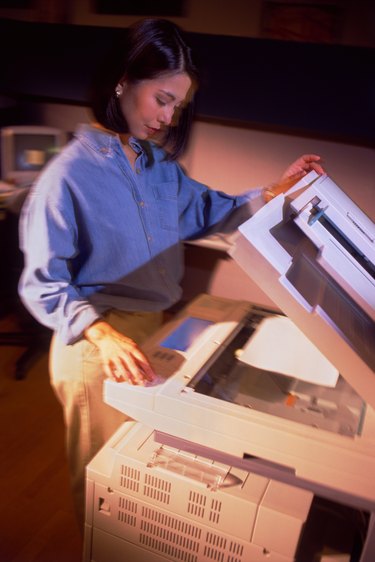
Although your trusty office Xerox machine does emit a kind of radiation, the good news is that it doesn't produce the truly harmful emissions most people associate with radiation -- X-rays, alpha particles and the like. It does, however, use very bright light, a part of which can cause long-term harm if you don't take some basic precautions.
Copying Process
Video of the Day
A Xerox machine works by exposing a document to bright light. The light reflects off the paper, forming an image on a small metal drum coated with a photosensitive material. A mechanism lays a charge of static electricity on the drum; when light hits it, it selectively removes the static charge where the light is brightest. The static charge attracts black toner powder and a set of rollers press a page against the drum, forcing the toner into the paper. Although the process uses high-voltage electricity, the mechanism and cabinet insulates this safely from the operator, and it does not produce X-ray radiation.
Video of the Day
Radiation
Although you may associate the term "radiation" with danger, from a scientific standpoint it simply means "energy coming from an object." This includes light from lamps, computer monitors and smartphone screens. Seen this way, a Xerox machine does produce radiation in the form of light, but that kind of radiation is not a cause for concern.
Ionizing Radiation
The forms of radiation that are actually harmful are more energetic than ordinary light. They have enough energy to strip electrons from atoms; this is bad because it also damages the complex molecules that make up living things, including people. This is called "ionizing radiation" and you normally want to stay away from it, unless it takes the form of a dental X-ray, for example. Some of the light that comes from a Xerox copier is not as harmful as an X-ray, but has enough energy to warrant caution when you use the machine.
Ultraviolet Light
Light, or electromagnetic radiation, is a continuous spread of frequencies ranging from infrared through visible light, and continues through X-rays and gamma rays as its energy increases. Sandwiched between visible violet light and X-rays is ultraviolet light, best known for black lights and germicidal lamps in hospitals. The bright light from some Xerox machines contains a weak form of UV. For this reason, it's not a good idea to run a copier with the lid up for long periods of time, especially if you're staring at the bright light, as your eyes and skin are sensitive to UV light and may suffer damage. To avoid the UV light, simply close the lid when you make copies, or use the automatic feed mechanism found on many modern copiers.